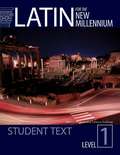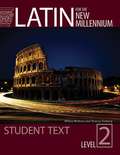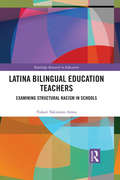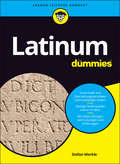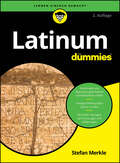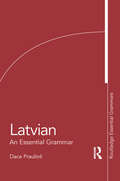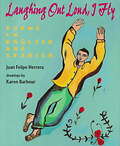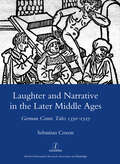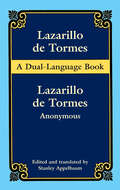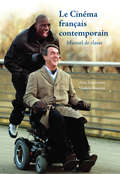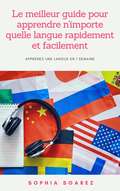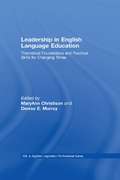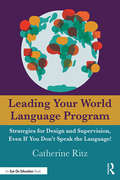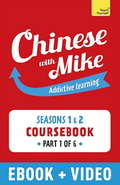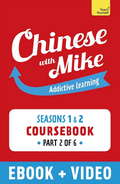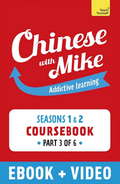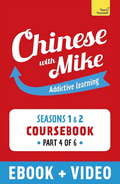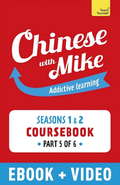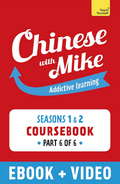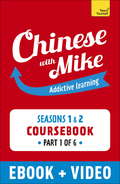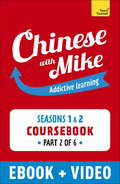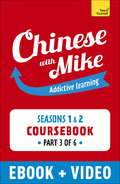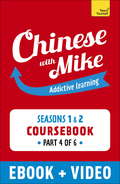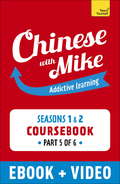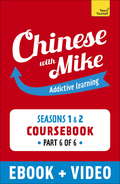- Table View
- List View
Latin for the New Millennium Student Text, Level 1
by Terence Tunberg Milena MinkovaNIMAC-sourced textbook
Latina Bilingual Education Teachers: Examining Structural Racism in Schools (Routledge Research in Education #22)
by Yukari Takimoto AmosUsing critical race theory and whiteness studies as theoretical frameworks, this book traces two Latina bilingual education teachers in three different professional phases: as paraprofessionals, teacher candidates, and certified teachers. Grounded in a longitudinal case study, this book sheds light on the effects of institutional racism when Latina/o educational professionals attempt inclusion in white dominant organizations, such as schools. Revealing and analyzing the structural racism present in schools and the obstacles it creates for professionals of color, the author exposes the racist practices that are hidden from view and offer practical solutions to combat them.
Latinum für Dummies (Für Dummies)
by Stefan MerkleGehören auch Sie zu den Studierenden, die an der Uni das Latinum nachholen müssen, weil es eine Voraussetzung für Ihren Abschluss ist, Sie aber in der Schule Latein nicht belegt hatten? Da gibt es sicher Angenehmeres. Aber wenn Sie schon im Lateinkurs sitzen, sollte das Lernen zumindest Spaß machen. Dieses Buch bereitet Sie auf die Klausur vor und hilft Ihnen, sie zu bestehen, auch wenn Sie zuvor keine Lateinkenntnisse hatten. Schritt für Schritt führt Stefan Merkle Sie in die lateinische Grammatik ein. Der Autor weiß, wo es hakt und welche grammatischen Formen besonders knifflig sind. Er vermittelt Übersetzungstechniken und weist Sie auf die häufigsten Fehlerquellen hin. Und nach den nachvollziehbaren Erklärungen heißt es dann üben, üben, üben - getreu dem Motto von null bis Caesar!
Latinum für Dummies (Für Dummies)
by Stefan MerkleVon Null bis Caesar: So kommen Sie gut durch die Latinumsklausur Gehören Sie zu den Studierenden, die an der Uni das Latinum nachholen müssen, weil es eine Voraussetzung für Ihren Abschluss ist, Sie aber in der Schule kein Latein hatten? Wenn es schon sein muss, sollte das Lernen zumindest Spaß machen. Dafür sorgt dieses Buch. Stefan Merkle führt Sie Schritt für Schritt mit nachvollziehbaren Erklärungen in die lateinische Grammatik ein. Er zeigt Ihnen, worauf Sie besonders achten müssen und wie Sie Unfälle beim Lateinübersetzen am sichersten vermeiden. Obendrein erfahren Sie eine Menge über die Antike und darüber, wo Sie ihr heute noch ständig begegnen. Sie erfahren Wie Sie Latein am besten lernen Wie Sie sich einen soliden Grundwortschatz aneignen Wie Sie sich sicher durch Formen und Syntax bewegen Welche Spuren die Römer in unserer Kultur hinterlassen haben
Latvian: The Complete Course For Beginners (Routledge Essential Grammars)
by Dace PraulinšLatvian: An Essential Grammar is a concise, user-friendly guide to the basic grammatical structures of Latvian. Presenting a fresh and accessible description of the language, this engaging grammar uses clear, jargon-free explanations to set out the complexities of Latvian in short, readable sections. Key features include: clear grammar explanations frequent use of authentic examples pronunciation guide, bibliography and subject index. This is the ideal reference source both for those studying Latvian independently and for students in schools, colleges, universities and adult classes of all types to back up their studies.
Laughing Out Loud, I Fly: A Carcajadas Yo Vuelo
by Juan Felipe HerreraA collection of poems in Spanish and English about childhood, place, and identity.
Laughter and Narrative in the Later Middle Ages: German Comic Tales C.1350-1525
by Sebastian CoxonIn contrast to the vernacular literary traditions of France, Italy and England, comic tales in verse flourished in late medieval Germany, providing bawdy entertainment for larger audiences of public recitals as well as for smaller numbers of individual readers. In a sustained close analysis Sebastian Coxon explores both the narrative design and fundamental thematic preoccupations of these short texts. A distinctively performative tradition of pre-modern narrative literature emerges which invited its recipients to think, learn and above all to laugh in a number of different ways.
Lazarillo de Tormes (Dover Dual Language Spanish)
by Anonymous Stanley AppelbaumThe first picaresque novel, and one of the gems of Spanish literature. A brief, simply told tale of a rogue's adventures and misadventures -- full of laconic cynicism and spiced with puns and wordplay. Introduction, Notes, and new English translation by Stanley Appelbaum.
Le Cinéma français contemporain: Manuel de Classe
by Alan J. Singerman Michèle BissièreThrough its analyses of twenty notable and representative French films that have appeared since 1980, Le Cinéma français contemporain: Manuel de classe offers an eagle-eyed view of recent French cinema that will delight advanced students of French as well as Francophone students of French film.
Le meilleur guide pour apprendre n'importe quelle langue rapidement et facilement: Apprenez une langue en 1 semaine
by Sophia SoarezUn guide détaillé pour apprendre n'importe quelle langue de manière simple et rapide Ce guide vous aidera à apprendre une nouvelle langue en 1 semaine et vous enseignera des trucs et astuces pour devenir un locuteur natif de la nouvelle langue. Basé sur des faits scientifiques, ce livre vous expliquera comment: -trouver moyen le plus simple d'apprendre une nouvelle langue -passer le temps de manière efficace -devenir locuteur natif -apprendre la prononciation correcte de la nouvelle langue -positionner la bouche pour une prononciation correcte -mémoriser des mots d'une nouvelle langue -rester motivé -améliorer l'accent Si vous voulez apprendre une nouvelle langue en une semaine et devenir un locuteur natif, alors ce livre est pour vous. -> Faites glisser vers le haut de la page et cliquez sur Ajouter dans le panier pour acheter instantanément Avis de non-responsabilité: Cet auteur et/ou le ou les titulaires des droits ne font aucune réclamation, promesse ou garantie quant à l'exactitude, l'exhaustivité ou l'adéquation du contenu de ce livre, et décline expressément toute responsabilité pour les erreurs et omissions dans le contenu. Ce produit est destiné à un usage de référence uniquement.
Leadership in English Language Education: Theoretical Foundations and Practical Skills for Changing Times (ESL & Applied Linguistics Professional Series)
by MaryAnn Christison Denise E. MurrayLeadership in English Language Education: Theoretical Foundations and Practical Skills for Changing Times presents both theoretical approaches to leadership and practical skills leaders in English language education need to be effective. Discussing practical skills in detail, and providing readers with the opportunity to acquire new skills and apply them in their own contexts, the text is organized around three themes: The roles and characteristics of leaders Skills for leading ELT leadership in practice Leadership theories and approaches from business and industry are applied to and conclusions are drawn for English language teaching in a variety of organizational contexts, including intensive English programs in English-speaking countries, TESOL departments in universities, ESL programs in community colleges, EFL departments in non-English speaking countries, adult education programs, and commercial ELT centers and schools around the world. This is an essential resource for all administrators, teachers, academics, and teacher candidates in English language education.
Leading Your World Language Program: Strategies for Design and Supervision, Even If You Don’t Speak the Language!
by Catherine RitzAn essential resource for district, school, and program leaders who supervise, evaluate, or otherwise support World Language programs, this book provides clear, practical guidance on leading an exemplary K–12 World Language program. No matter whether you speak the language, the effective approaches in this book will equip you with the tools you need to implement and evaluate World Language curricula in your school. Catherine Ritz provides a clear and research-based framework for World Language instruction aligned to rigorous national and state standards, and addresses essential concepts and topics, including program and curriculum design, assessment and evaluation, and strategic planning. Whether you are a World Language department chair with years of experience, a school administrator with no background in language education, or a World Language teacher, you will find much to use in this book. It is chock-full of ready-to-use resources and tools, including: Templates for program and unit planning, observation protocols, and sample assessments World LAnguage program models for different age ranges, and a sample curriculum unit Additional resource lists and further reading recommendations.
Learn Chinese with Mike Absolute Beginner Coursebook Seasons 1 & 2: Enhanced Edition Part 1
by Mike Hainzinger"It is definitely new, and it definitely works." -Dr. Licheng Gu, Program Director, African & Asian Languages, Northwestern UniversityWhat do I get when I learn Chinese with Mike?This ebook contains 10 video-based lessons and is part one of a series of six. It features audio and visual learning material and works best on tablets and smartphones.Addictive learningMike Laoshi (Teacher Mike) will astound you with his unparalleled ability to make learning Mandarin Chinese fun and easy. Be warned, his teaching style is highly addictive, so if you have a family, career or social life, you may want to put those on hold for a little while.Why Chinese with Mike?Chinese with Mike is 100% new and breaks with traditional Chinese curricula. Mike's humour, mixed with his logical, step-by-step approach shields learners from the unnecessary complexities of Mandarin Chinese. Through a blend of short and highly addictive video lessons, you'll acquire essential Chinese with confidence. More importantly, you get a little one-on-one time with Mike, as he makes learning Chinese ridiculously easy-and fun!What will I learn?This is a solid foundation course that teaches you how to speak Chinese and also understand how the language fits together.Season 1 Covers pinyin, the four tones and writing system using Simplified Chinese characters, common words, phrases and typical conversations. In no time you'll be able to talk about yourself, your family, your friends, your job, your home, your dogs and cats. Season 2 If Season 2 wasn't included, you wouldn't be able to tell people you can speak Chinese, you like to play basketball, or you want to eat beef fried rice. More importantly, you wouldn't even know how to ask permission to use the bathroom! Without Season 2 you wouldn't get very far in life. Why will learning Chinese be a breeze?· Mike builds confidence through his logical step-by-step design of the course· Mike explains pronunciation with clear, familiar examples· Mike adds interesting facts about the intricacies of language· Mike includes lots of cultural tidbits· Mike recognizes and explains thoroughly troublesome areas· Mike uses native speakers to help you with listening and speakingChinese with Mike is suitable for classroom, self-study or home schooling.Praise for MikeThe coolest Chinese teacher out there. Totally rad!! confusedlaowai.comLike a rock star teacher. Excellent for beginners. Entertaining too! socialmandarin.comAs an instructor, I have found Prof. Hainzinger's teaching material was very practical; it was very easy to be inserted into our classroom activities because of its fragmented structural style, and its companying video files. In addition, the students really appreciated the lively style of the text, as well the vivid video contributions.Yuxiang Liu Lecturer in Chinese, EALC The University of Chicago
Learn Chinese with Mike Absolute Beginner Coursebook Seasons 1 & 2: Enhanced Edition Part 2
by Mike Hainzinger"It is definitely new, and it definitely works." -Dr. Licheng Gu, Program Director, African & Asian Languages, Northwestern UniversityWhat do I get when I learn Chinese with Mike?This ebook contains 10 video-based lessons and is part two of a series of six. It features audio and visual learning material and works best on tablets and smartphones.Addictive learningMike Laoshi (Teacher Mike) will astound you with his unparalleled ability to make learning Mandarin Chinese fun and easy. Be warned, his teaching style is highly addictive, so if you have a family, career or social life, you may want to put those on hold for a little while.Why Chinese with Mike?Chinese with Mike is 100% new and breaks with traditional Chinese curricula. Mike's humour, mixed with his logical, step-by-step approach shields learners from the unnecessary complexities of Mandarin Chinese. Through a blend of short and highly addictive video lessons, you'll acquire essential Chinese with confidence. More importantly, you get a little one-on-one time with Mike, as he makes learning Chinese ridiculously easy-and fun!What will I learn?This is a solid foundation course that teaches you how to speak Chinese and also understand how the language fits together.Season 1 Covers pinyin, the four tones and writing system using Simplified Chinese characters, common words, phrases and typical conversations. In no time you'll be able to talk about yourself, your family, your friends, your job, your home, your dogs and cats. Season 2 If Season 2 wasn't included, you wouldn't be able to tell people you can speak Chinese, you like to play basketball, or you want to eat beef fried rice. More importantly, you wouldn't even know how to ask permission to use the bathroom! Without Season 2 you wouldn't get very far in life. Why will learning Chinese be a breeze?· Mike builds confidence through his logical step-by-step design of the course· Mike explains pronunciation with clear, familiar examples· Mike adds interesting facts about the intricacies of language· Mike includes lots of cultural tidbits· Mike recognizes and explains thoroughly troublesome areas· Mike uses native speakers to help you with listening and speakingChinese with Mike is suitable for classroom, self-study or home schooling.Praise for MikeThe coolest Chinese teacher out there. Totally rad!! confusedlaowai.comLike a rock star teacher. Excellent for beginners. Entertaining too! socialmandarin.comAs an instructor, I have found Prof. Hainzinger's teaching material was very practical; it was very easy to be inserted into our classroom activities because of its fragmented structural style, and its companying video files. In addition, the students really appreciated the lively style of the text, as well the vivid video contributions.Yuxiang Liu Lecturer in Chinese, EALC The University of Chicago
Learn Chinese with Mike Absolute Beginner Coursebook Seasons 1 & 2: Enhanced Edition Part 3
by Mike Hainzinger"It is definitely new, and it definitely works." -Dr. Licheng Gu, Program Director, African & Asian Languages, Northwestern UniversityWhat do I get when I learn Chinese with Mike?This ebook contains 10 video-based lessons and is part three of a series of six. It features audio and visual learning material and works best on tablets and smartphones.Addictive learningMike Laoshi (Teacher Mike) will astound you with his unparalleled ability to make learning Mandarin Chinese fun and easy. Be warned, his teaching style is highly addictive, so if you have a family, career or social life, you may want to put those on hold for a little while.Why Chinese with Mike?Chinese with Mike is 100% new and breaks with traditional Chinese curricula. Mike's humour, mixed with his logical, step-by-step approach shields learners from the unnecessary complexities of Mandarin Chinese. Through a blend of short and highly addictive video lessons, you'll acquire essential Chinese with confidence. More importantly, you get a little one-on-one time with Mike, as he makes learning Chinese ridiculously easy-and fun!What will I learn?This is a solid foundation course that teaches you how to speak Chinese and also understand how the language fits together.Season 1 Covers pinyin, the four tones and writing system using Simplified Chinese characters, common words, phrases and typical conversations. In no time you'll be able to talk about yourself, your family, your friends, your job, your home, your dogs and cats. Season 2 If Season 2 wasn't included, you wouldn't be able to tell people you can speak Chinese, you like to play basketball, or you want to eat beef fried rice. More importantly, you wouldn't even know how to ask permission to use the bathroom! Without Season 2 you wouldn't get very far in life. Why will learning Chinese be a breeze?· Mike builds confidence through his logical step-by-step design of the course· Mike explains pronunciation with clear, familiar examples· Mike adds interesting facts about the intricacies of language· Mike includes lots of cultural tidbits· Mike recognizes and explains thoroughly troublesome areas· Mike uses native speakers to help you with listening and speakingChinese with Mike is suitable for classroom, self-study or home schooling.Praise for MikeThe coolest Chinese teacher out there. Totally rad!! confusedlaowai.comLike a rock star teacher. Excellent for beginners. Entertaining too! socialmandarin.comAs an instructor, I have found Prof. Hainzinger's teaching material was very practical; it was very easy to be inserted into our classroom activities because of its fragmented structural style, and its companying video files. In addition, the students really appreciated the lively style of the text, as well the vivid video contributions.Yuxiang Liu Lecturer in Chinese, EALC The University of Chicago
Learn Chinese with Mike Absolute Beginner Coursebook Seasons 1 & 2: Enhanced Edition Part 4
by Mike Hainzinger"It is definitely new, and it definitely works." -Dr. Licheng Gu, Program Director, African & Asian Languages, Northwestern UniversityWhat do I get when I learn Chinese with Mike?This ebook contains 10 video-based lessons and is part four of a series of six. It features audio and visual learning material and works best on tablets and smartphones.Addictive learningMike Laoshi (Teacher Mike) will astound you with his unparalleled ability to make learning Mandarin Chinese fun and easy. Be warned, his teaching style is highly addictive, so if you have a family, career or social life, you may want to put those on hold for a little while.Why Chinese with Mike?Chinese with Mike is 100% new and breaks with traditional Chinese curricula. Mike's humour, mixed with his logical, step-by-step approach shields learners from the unnecessary complexities of Mandarin Chinese. Through a blend of short and highly addictive video lessons, you'll acquire essential Chinese with confidence. More importantly, you get a little one-on-one time with Mike, as he makes learning Chinese ridiculously easy-and fun!What will I learn?This is a solid foundation course that teaches you how to speak Chinese and also understand how the language fits together.Season 1 Covers pinyin, the four tones and writing system using Simplified Chinese characters, common words, phrases and typical conversations. In no time you'll be able to talk about yourself, your family, your friends, your job, your home, your dogs and cats. Season 2 If Season 2 wasn't included, you wouldn't be able to tell people you can speak Chinese, you like to play basketball, or you want to eat beef fried rice. More importantly, you wouldn't even know how to ask permission to use the bathroom! Without Season 2 you wouldn't get very far in life. Why will learning Chinese be a breeze?· Mike builds confidence through his logical step-by-step design of the course· Mike explains pronunciation with clear, familiar examples· Mike adds interesting facts about the intricacies of language· Mike includes lots of cultural tidbits· Mike recognizes and explains thoroughly troublesome areas· Mike uses native speakers to help you with listening and speakingChinese with Mike is suitable for classroom, self-study or home schooling.Praise for MikeThe coolest Chinese teacher out there. Totally rad!! confusedlaowai.comLike a rock star teacher. Excellent for beginners. Entertaining too! socialmandarin.comAs an instructor, I have found Prof. Hainzinger's teaching material was very practical; it was very easy to be inserted into our classroom activities because of its fragmented structural style, and its companying video files. In addition, the students really appreciated the lively style of the text, as well the vivid video contributions.Yuxiang Liu Lecturer in Chinese, EALC The University of Chicago
Learn Chinese with Mike Absolute Beginner Coursebook Seasons 1 & 2: Enhanced Edition Part 5
by Mike Hainzinger"It is definitely new, and it definitely works." -Dr. Licheng Gu, Program Director, African & Asian Languages, Northwestern UniversityWhat do I get when I learn Chinese with Mike?This ebook contains 10 video-based lessons and is part five of a series of six. It features audio and visual learning material and works best on tablets and smartphones.Addictive learningMike Laoshi (Teacher Mike) will astound you with his unparalleled ability to make learning Mandarin Chinese fun and easy. Be warned, his teaching style is highly addictive, so if you have a family, career or social life, you may want to put those on hold for a little while.Why Chinese with Mike?Chinese with Mike is 100% new and breaks with traditional Chinese curricula. Mike's humour, mixed with his logical, step-by-step approach shields learners from the unnecessary complexities of Mandarin Chinese. Through a blend of short and highly addictive video lessons, you'll acquire essential Chinese with confidence. More importantly, you get a little one-on-one time with Mike, as he makes learning Chinese ridiculously easy-and fun!What will I learn?This is a solid foundation course that teaches you how to speak Chinese and also understand how the language fits together.Season 1 Covers pinyin, the four tones and writing system using Simplified Chinese characters, common words, phrases and typical conversations. In no time you'll be able to talk about yourself, your family, your friends, your job, your home, your dogs and cats. Season 2 If Season 2 wasn't included, you wouldn't be able to tell people you can speak Chinese, you like to play basketball, or you want to eat beef fried rice. More importantly, you wouldn't even know how to ask permission to use the bathroom! Without Season 2 you wouldn't get very far in life. Why will learning Chinese be a breeze?· Mike builds confidence through his logical step-by-step design of the course· Mike explains pronunciation with clear, familiar examples· Mike adds interesting facts about the intricacies of language· Mike includes lots of cultural tidbits· Mike recognizes and explains thoroughly troublesome areas· Mike uses native speakers to help you with listening and speakingChinese with Mike is suitable for classroom, self-study or home schooling.Praise for MikeThe coolest Chinese teacher out there. Totally rad!! confusedlaowai.comLike a rock star teacher. Excellent for beginners. Entertaining too! socialmandarin.comAs an instructor, I have found Prof. Hainzinger's teaching material was very practical; it was very easy to be inserted into our classroom activities because of its fragmented structural style, and its companying video files. In addition, the students really appreciated the lively style of the text, as well the vivid video contributions.Yuxiang Liu Lecturer in Chinese, EALC The University of Chicago
Learn Chinese with Mike Absolute Beginner Coursebook Seasons 1 & 2: Enhanced Edition Part 6
by Mike Hainzinger"It is definitely new, and it definitely works." -Dr. Licheng Gu, Program Director, African & Asian Languages, Northwestern UniversityWhat do I get when I learn Chinese with Mike?This ebook contains 10 video-based lessons and is part six of a series of six. It features audio and visual learning material and works best on tablets and smartphones.Addictive learningMike Laoshi (Teacher Mike) will astound you with his unparalleled ability to make learning Mandarin Chinese fun and easy. Be warned, his teaching style is highly addictive, so if you have a family, career or social life, you may want to put those on hold for a little while.Why Chinese with Mike?Chinese with Mike is 100% new and breaks with traditional Chinese curricula. Mike's humour, mixed with his logical, step-by-step approach shields learners from the unnecessary complexities of Mandarin Chinese. Through a blend of short and highly addictive video lessons, you'll acquire essential Chinese with confidence. More importantly, you get a little one-on-one time with Mike, as he makes learning Chinese ridiculously easy-and fun!What will I learn?This is a solid foundation course that teaches you how to speak Chinese and also understand how the language fits together.Season 1 Covers pinyin, the four tones and writing system using Simplified Chinese characters, common words, phrases and typical conversations. In no time you'll be able to talk about yourself, your family, your friends, your job, your home, your dogs and cats. Season 2 If Season 2 wasn't included, you wouldn't be able to tell people you can speak Chinese, you like to play basketball, or you want to eat beef fried rice. More importantly, you wouldn't even know how to ask permission to use the bathroom! Without Season 2 you wouldn't get very far in life. Why will learning Chinese be a breeze?· Mike builds confidence through his logical step-by-step design of the course· Mike explains pronunciation with clear, familiar examples· Mike adds interesting facts about the intricacies of language· Mike includes lots of cultural tidbits· Mike recognizes and explains thoroughly troublesome areas· Mike uses native speakers to help you with listening and speakingChinese with Mike is suitable for classroom, self-study or home schooling.Praise for MikeThe coolest Chinese teacher out there. Totally rad!! confusedlaowai.comLike a rock star teacher. Excellent for beginners. Entertaining too! socialmandarin.comAs an instructor, I have found Prof. Hainzinger's teaching material was very practical; it was very easy to be inserted into our classroom activities because of its fragmented structural style, and its companying video files. In addition, the students really appreciated the lively style of the text, as well the vivid video contributions.Yuxiang Liu Lecturer in Chinese, EALC The University of Chicago
Learn Chinese with Mike Absolute Beginner Coursebook Seasons 1 & 2: Part 1
by Mike Hainzinger"It is definitely new, and it definitely works."-Dr. Licheng Gu, Program Director, African & Asian Languages, Northwestern UniversityWhat do I get when I learn Chinese with Mike?This ebook contains 10 video-based lessons and is part one of a series of six. It features audio and visual learning material and works best on tablets and smartphones.Addictive learningMike Laoshi (Teacher Mike) will astound you with his unparalleled ability to make learning Mandarin Chinese fun and easy. Be warned, his teaching style is highly addictive, so if you have a family, career or social life, you may want to put those on hold for a little while.Why Chinese with Mike?Chinese with Mike is 100% new and breaks with traditional Chinese curricula. Mike's humour, mixed with his logical, step-by-step approach shields learners from the unnecessary complexities of Mandarin Chinese. Through a blend of short and highly addictive video lessons, you'll acquire essential Chinese with confidence. More importantly, you get a little one-on-one time with Mike, as he makes learning Chinese ridiculously easy-and fun!What will I learn?This is a solid foundation course that teaches you how to speak Chinese and also understand how the language fits together.Season 1 Covers pinyin, the four tones and writing system using Simplified Chinese characters, common words, phrases and typical conversations. In no time you'll be able to talk about yourself, your family, your friends, your job, your home, your dogs and cats. Season 2 If Season 2 wasn't included, you wouldn't be able to tell people you can speak Chinese, you like to play basketball, or you want to eat beef fried rice. More importantly, you wouldn't even know how to ask permission to use the bathroom! Without Season 2 you wouldn't get very far in life. Why will learning Chinese be a breeze?· Mike builds confidence through his logical step-by-step design of the course· Mike explains pronunciation with clear, familiar examples· Mike adds interesting facts about the intricacies of language· Mike includes lots of cultural tidbits· Mike recognizes and explains thoroughly troublesome areas· Mike uses native speakers to help you with listening and speakingChinese with Mike is suitable for classroom, self-study or home schooling.Praise for MikeThe coolest Chinese teacher out there. Totally rad!! confusedlaowai.comLike a rock star teacher. Excellent for beginners. Entertaining too! socialmandarin.comAs an instructor, I have found Prof. Hainzinger's teaching material was very practical; it was very easy to be inserted into our classroom activities because of its fragmented structural style, and its companying video files. In addition, the students really appreciated the lively style of the text, as well the vivid video contributions.Yuxiang Liu Lecturer in Chinese, EALC The University of Chicago
Learn Chinese with Mike Absolute Beginner Coursebook Seasons 1 & 2: Part 2
by Mike Hainzinger"It is definitely new, and it definitely works." -Dr. Licheng Gu, Program Director, African & Asian Languages, Northwestern UniversityWhat do I get when I learn Chinese with Mike?This ebook contains 10 video-based lessons and is part two of a series of six. It features audio and visual learning material and works best on tablets and smartphones.Addictive learningMike Laoshi (Teacher Mike) will astound you with his unparalleled ability to make learning Mandarin Chinese fun and easy. Be warned, his teaching style is highly addictive, so if you have a family, career or social life, you may want to put those on hold for a little while.Why Chinese with Mike?Chinese with Mike is 100% new and breaks with traditional Chinese curricula. Mike's humour, mixed with his logical, step-by-step approach shields learners from the unnecessary complexities of Mandarin Chinese. Through a blend of short and highly addictive video lessons, you'll acquire essential Chinese with confidence. More importantly, you get a little one-on-one time with Mike, as he makes learning Chinese ridiculously easy-and fun!What will I learn?This is a solid foundation course that teaches you how to speak Chinese and also understand how the language fits together.Season 1 Covers pinyin, the four tones and writing system using Simplified Chinese characters, common words, phrases and typical conversations. In no time you'll be able to talk about yourself, your family, your friends, your job, your home, your dogs and cats. Season 2 If Season 2 wasn't included, you wouldn't be able to tell people you can speak Chinese, you like to play basketball, or you want to eat beef fried rice. More importantly, you wouldn't even know how to ask permission to use the bathroom! Without Season 2 you wouldn't get very far in life. Why will learning Chinese be a breeze?· Mike builds confidence through his logical step-by-step design of the course· Mike explains pronunciation with clear, familiar examples· Mike adds interesting facts about the intricacies of language· Mike includes lots of cultural tidbits· Mike recognizes and explains thoroughly troublesome areas· Mike uses native speakers to help you with listening and speakingChinese with Mike is suitable for classroom, self-study or home schooling.Praise for MikeThe coolest Chinese teacher out there. Totally rad!! confusedlaowai.comLike a rock star teacher. Excellent for beginners. Entertaining too! socialmandarin.comAs an instructor, I have found Prof. Hainzinger's teaching material was very practical; it was very easy to be inserted into our classroom activities because of its fragmented structural style, and its companying video files. In addition, the students really appreciated the lively style of the text, as well the vivid video contributions.Yuxiang Liu Lecturer in Chinese, EALC The University of Chicago
Learn Chinese with Mike Absolute Beginner Coursebook Seasons 1 & 2: Part 3
by Mike Hainzinger"It is definitely new, and it definitely works." -Dr. Licheng Gu, Program Director, African & Asian Languages, Northwestern UniversityWhat do I get when I learn Chinese with Mike?This ebook contains 10 video-based lessons and is part three of a series of six. It features audio and visual learning material and works best on tablets and smartphones.Addictive learningMike Laoshi (Teacher Mike) will astound you with his unparalleled ability to make learning Mandarin Chinese fun and easy. Be warned, his teaching style is highly addictive, so if you have a family, career or social life, you may want to put those on hold for a little while.Why Chinese with Mike?Chinese with Mike is 100% new and breaks with traditional Chinese curricula. Mike's humour, mixed with his logical, step-by-step approach shields learners from the unnecessary complexities of Mandarin Chinese. Through a blend of short and highly addictive video lessons, you'll acquire essential Chinese with confidence. More importantly, you get a little one-on-one time with Mike, as he makes learning Chinese ridiculously easy-and fun!What will I learn?This is a solid foundation course that teaches you how to speak Chinese and also understand how the language fits together.Season 1 Coverscovers pinyin, the four tones and writing system using Simplified Chinese characters, common words, phrases and typical conversations. In no time you'll be able to talk about yourself, your family, your friends, your job, your home, your dogs and cats. Season 2 If Season 2 wasn't included, you wouldn't be able to tell people you can speak Chinese, you like to play basketball, or you want to eat beef fried rice. More importantly, you wouldn't even know how to ask permission to use the bathroom! Without Season 2 you wouldn't get very far in life. Why will learning Chinese be a breeze?· Mike builds confidence through his logical step-by-step design of the course· Mike explains pronunciation with clear, familiar examples· Mike adds interesting facts about the intricacies of language· Mike includes lots of cultural tidbits· Mike recognizes and explains thoroughly troublesome areas· Mike uses native speakers to help you with listening and speakingChinese with Mike is suitable for classroom, self-study or home schooling.Praise for MikeThe coolest Chinese teacher out there. Totally rad!! confusedlaowai.comLike a rock star teacher. Excellent for beginners. Entertaining too! socialmandarin.comAs an instructor, I have found Prof. Hainzinger's teaching material was very practical; it was very easy to be inserted into our classroom activities because of its fragmented structural style, and its companying video files. In addition, the students really appreciated the lively style of the text, as well the vivid video contributions.Yuxiang Liu Lecturer in Chinese, EALC The University of Chicago
Learn Chinese with Mike Absolute Beginner Coursebook Seasons 1 & 2: Part 4
by Mike Hainzinger"It is definitely new, and it definitely works." -Dr. Licheng Gu, Program Director, African & Asian Languages, Northwestern UniversityWhat do I get when I learn Chinese with Mike?This ebook contains 10 video-based lessons and is part four of a series of six. It features audio and visual learning material and works best on tablets and smartphones.Addictive learningMike Laoshi (Teacher Mike) will astound you with his unparalleled ability to make learning Mandarin Chinese fun and easy. Be warned, his teaching style is highly addictive, so if you have a family, career or social life, you may want to put those on hold for a little while.Why Chinese with Mike?Chinese with Mike is 100% new and breaks with traditional Chinese curricula. Mike's humour, mixed with his logical, step-by-step approach shields learners from the unnecessary complexities of Mandarin Chinese. Through a blend of short and highly addictive video lessons, you'll acquire essential Chinese with confidence. More importantly, you get a little one-on-one time with Mike, as he makes learning Chinese ridiculously easy-and fun!What will I learn?This is a solid foundation course that teaches you how to speak Chinese and also understand how the language fits together.Season 1 Covers pinyin, the four tones and writing system using Simplified Chinese characters, common words, phrases and typical conversations. In no time you'll be able to talk about yourself, your family, your friends, your job, your home, your dogs and cats. Season 2 If Season 2 wasn't included, you wouldn't be able to tell people you can speak Chinese, you like to play basketball, or you want to eat beef fried rice. More importantly, you wouldn't even know how to ask permission to use the bathroom! Without Season 2 you wouldn't get very far in life. Why will learning Chinese be a breeze?· Mike builds confidence through his logical step-by-step design of the course· Mike explains pronunciation with clear, familiar examples· Mike adds interesting facts about the intricacies of language· Mike includes lots of cultural tidbits· Mike recognizes and explains thoroughly troublesome areas· Mike uses native speakers to help you with listening and speakingChinese with Mike is suitable for classroom, self-study or home schooling.Praise for MikeThe coolest Chinese teacher out there. Totally rad!! confusedlaowai.comLike a rock star teacher. Excellent for beginners. Entertaining too! socialmandarin.comAs an instructor, I have found Prof. Hainzinger's teaching material was very practical; it was very easy to be inserted into our classroom activities because of its fragmented structural style, and its companying video files. In addition, the students really appreciated the lively style of the text, as well the vivid video contributions.Yuxiang Liu Lecturer in Chinese, EALC The University of Chicago
Learn Chinese with Mike Absolute Beginner Coursebook Seasons 1 & 2: Part 5
by Mike Hainzinger"It is definitely new, and it definitely works." -Dr. Licheng Gu, Program Director, African & Asian Languages, Northwestern UniversityWhat do I get when I learn Chinese with Mike?This ebook contains 10 video-based lessons and is part five of a series of six. It features audio and visual learning material and works best on tablets and smartphones.Addictive learningMike Laoshi (Teacher Mike) will astound you with his unparalleled ability to make learning Mandarin Chinese fun and easy. Be warned, his teaching style is highly addictive, so if you have a family, career or social life, you may want to put those on hold for a little while.Why Chinese with Mike?Chinese with Mike is 100% new and breaks with traditional Chinese curricula. Mike's humour, mixed with his logical, step-by-step approach shields learners from the unnecessary complexities of Mandarin Chinese. Through a blend of short and highly addictive video lessons, you'll acquire essential Chinese with confidence. More importantly, you get a little one-on-one time with Mike, as he makes learning Chinese ridiculously easy-and fun!What will I learn?This is a solid foundation course that teaches you how to speak Chinese and also understand how the language fits together.Season 1 Covers pinyin, the four tones and writing system using Simplified Chinese characters, common words, phrases and typical conversations. In no time you'll be able to talk about yourself, your family, your friends, your job, your home, your dogs and cats. Season 2 If Season 2 wasn't included, you wouldn't be able to tell people you can speak Chinese, you like to play basketball, or you want to eat beef fried rice. More importantly, you wouldn't even know how to ask permission to use the bathroom! Without Season 2 you wouldn't get very far in life. Why will learning Chinese be a breeze?· Mike builds confidence through his logical step-by-step design of the course· Mike explains pronunciation with clear, familiar examples· Mike adds interesting facts about the intricacies of language· Mike includes lots of cultural tidbits· Mike recognizes and explains thoroughly troublesome areas· Mike uses native speakers to help you with listening and speakingChinese with Mike is suitable for classroom, self-study or home schooling.Praise for MikeThe coolest Chinese teacher out there. Totally rad!! confusedlaowai.comLike a rock star teacher. Excellent for beginners. Entertaining too! socialmandarin.comAs an instructor, I have found Prof. Hainzinger's teaching material was very practical; it was very easy to be inserted into our classroom activities because of its fragmented structural style, and its companying video files. In addition, the students really appreciated the lively style of the text, as well the vivid video contributions.Yuxiang Liu Lecturer in Chinese, EALC The University of Chicago
Learn Chinese with Mike Absolute Beginner Coursebook Seasons 1 & 2: Part 6
by Mike HainzingerThe curriculum has logical links that shield beginners from the unnecessary complexities of Chinese grammar while providing a solid understanding of how the language is constructed. It is definitely new, and it definitely works. -Dr. Licheng Gu, Program Director, WCAS African & Asian Languages, Northwestern UniversityWhat do I get when I learn Chinese with Mike?This ebook contains 10-video based lessons and is part six of a series of six. It features audio and visual learning material and works best on tablets and smartphones.Addictive learningMike Laoshi (Teacher Mike) will astound you with his unparalleled ability to make learning Mandarin Chinese fun and easy. Be warned, his teaching style is highly addictive, so if you have a family, career or social life, you may want to put those on hold for a little while.Why Chinese with Mike?Chinese with Mike is 100% new and breaks with traditional Chinese curricula. Mike's humour, mixed with his logical, step-by-step approach shields learners from the unnecessary complexities of Mandarin Chinese. Through a blend of short and highly addictive video lessons, you'll acquire essential Chinese with confidence. More importantly, you get a little one-on-one time with Mike, as he makes learning Chinese ridiculously easy-and fun!What will I learn?Seasons 1&2 is a solid foundation course that teaches you how to speak Chinese and also understand how the language fits together.Season 1 Covers pinyin, the four tones and writing system, common words, phrases and typical conversations. In no time you'll be able to talk about yourself, your family, your friends, your job, your home, your dogs and cats. Season 2 If Season 2 wasn't included, you wouldn't be able to tell people you can speak Chinese, you like to play basketball, or you want to eat beef fried rice. More importantly, you wouldn't even know how to ask permission to use the bathroom! Without Season 2 you wouldn't get very far in life. Why will learning Chinese be a breeze?· Mike builds confidence through his logical step-by-step design of the course· Mike explains pronunciation with clear, familiar examples· Mike adds interesting facts about the intricacies of language· Mike includes lots of cultural tidbits· Mike recognizes and explains thoroughly troublesome areas· Mike uses native speakers to help you with listening and speakingChinese with Mike is suitable for classroom, self-study or home schooling.Praise for MikeThe coolest Chinese teacher out there. Totally rad!! confusedlaowai.comLike a rock star teacher. Excellent for beginners. Entertaining too! socialmandarin.comAs an instructor, I have found Prof. Hainzinger's teaching material was very practical; it was very easy to be inserted into our classroom activities because of its fragmented structural style, and its companying video files. In addition, the students really appreciated the lively style of the text, as well the vivid video contributions.Yuxiang Liu Lecturer in Chinese, EALC The University of Chicago
